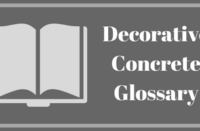There’s a lot riding on your price. It’s a reflection of your brand value and the perceived quality of your work. Customers will even use heuristics to determine if your price per square foot is consistent with what they would expect to gain from hiring you. Unfortunately, the process of determining the right price for your decorative concrete services is much more involved than throwing a dart at a wall of numbers.
According to Philip Kotler’s and Kevin Keller’s “Marketing Management,” setting your pricing policy requires selecting the pricing objective, determining demand, estimating costs, analyzing competitors’ costs and prices, selecting a pricing method, and selecting the final price.
Selecting the pricing objective
Having clear objectives will make it easier to set the right price. For those of you who are overwhelmed by intense competition or the ever-changing tastes of customers, survival might be an appropriate objective. However, simply surviving is a short-term strategy that will end in failure if you don’t eventually learn to add lasting value to your brand.
You might also consider choosing between maximizing profit and maximizing market share. The former means choosing a price that yields the most substantial profit margin. The latter means setting the lowest price possible, assuming your customers are price-sensitive.
Or, become the product-quality leader in your market by positioning your decorative services as an “affordable luxury.” This means setting your price just high enough to not be out of your customers’ reach and justifying it with high levels of perceived quality.
Determining customer demand
The first step in estimating demand is understanding price sensitivity, the degree to which the price of your decorative service affects your customers’ purchasing behavior.
Generally speaking, customers are more price-sensitive to premium services. They are also price-sensitive when there are many competitors in your market, they can immediately recognize the higher price, they are quick to change their buying habits, and they don’t think a higher price is justified. Perhaps you can see why decorative concrete customers are generally very price-sensitive.
Customers’ demand for your service can be estimated using various methods. For example, surveys give you focused insight into customers’ expectations about price and the associated quality of your work. Price experiments allow you to test and prove your pricing through trial and error until you identify the price that helps you achieve your objectives.
Estimating costs
Your decorative business will incur two types of costs, fixed and variable. Fixed costs do not vary with sales revenue. For example, you have to pay license fees, interest payments and salaries regardless of how many jobs you do in a year. On the other hand, variable costs vary as your sales increase. The amount you spend on brushes, rags and gasoline, for example, increases as you do more decorative jobs.
To set the right price, you must know how your costs vary from job to job. Take the case in which the monthly payment on a contractor’s truck is $400. If he stains a monthly average of 2,000 square feet, he can allocate toward the truck payment 20 cents per square foot (because 400 divided by 2,000 is 0.20). If he stains 4,000 square feet, he can allocate 10 cents per square foot. As the number of jobs (and the total project square footage) increases, the fixed costs are spread over more square feet and the average cost falls. Remember, if you fail to measure your costs correctly, you are not accurately measuring profit.
As you gain experience installing decorative concrete, your methods will improve. You’ll learn shortcuts and save on materials, and your installation costs will fall. In a nutshell, average costs fall with “accumulated production” experience.
In the graph on the facing page, the average cost to install the first 100,000 square feet each year in a given market is set at $2,000 per square foot. Once 400,000 square feet are installed in a year, the average cost falls to $1,600 per square foot. This decline in the average cost is often called the “learning curve” or “experience curve.”
Suppose three decorative contractors compete in this market, A, B and C. A has the lowest costs at $1,600 per square foot, having installed 400,000 square feet that year. If all three contractors stain concrete for $2,000 per square foot, A makes $400 profit per square foot, C makes $100 profit per square foot and B breaks even. The smart move for A would be to lower its price to $1,800. This will drive B out of the market, and even C may consider leaving. Then A has a good shot at picking up the business that would have gone to B (and possibly C).
Furthermore, price-sensitive customers will enter the market at the lowest price. As the number of installed square feet increases beyond 400,000 in a year, A’s costs will drop still further and faster, more than restoring its profits even at a price of $1,800 per square foot. This aggressive pricing strategy is risky, but it can help you gain market share and drive out competition.
Competitors’ costs and prices
Take into account your nearest competitors’ costs, prices and reactions when setting your price, since changing it can provoke a response. Research your competitors’ financial situation, recent sales, customer loyalty, and even their pricing objectives. If they have a market-share pricing objective, they will likely match any difference in price. If they have a profit-maximizing objective, they may respond by increasing their advertising budget or try to improve the quality of their work.
Selecting a price method
The most basic pricing method is to add a standard markup to your costs. Submit a job bid by estimating the total project cost and adding a standard markup for profit. This is a popular method because you can determine costs more easily than customer demand.
Use target-return pricing by determining the price that would yield your needed rate of return on investment. This pricing generally manifests itself in the form of a percentage.
You can also base your prices on your perceived value, which is comprised of product performance, warranties, customer support and reputation.
Even when you claim that your work is better than that of the competition, not all customers will respond positively. The key to perceived value pricing is to prove through marketing and service quality that your decorative work is more valuable.
Going-rate pricing is simply a matter of charging what your competition is charging or less.
NewLook International’s Certified Installers are trained to use a multiple of costs, generally between three and six times material costs, to select a price. Depressed markets necessitate a price closer to three times the cost of materials. Growth markets call for a price closer to six times the cost of materials. Do your due diligence to determine the state of your local economy.
Selecting the final price
Once you’ve selected your pricing method, consider how it will impact other aspects of your business. Take into account how your price will affect your brand as it relates to advertising. It must also be consistent with your company’s pricing policies. Finally, evaluate how your price might impact any other stakeholders of your company, including investors or even your product suppliers.
















